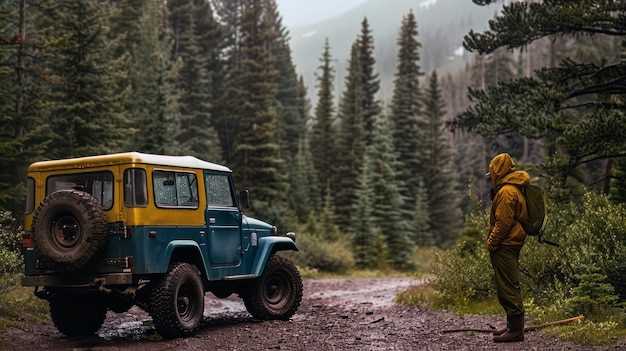
Off-road adventures can be exhilarating, offering a chance to connect with nature and explore rugged terrains. However, ensuring safety during these excursions is paramount. The unpredictable nature of off-road environments demands that every Jeep enthusiast be well-prepared. By prioritizing safety, you not only protect yourself but also enhance the overall enjoyment of your adventure.
Before hitting the trails, it’s essential to equip your vehicle with the proper safety gear. This includes recovery tools, first aid kits, and communication devices. Off-road driving can present unforeseen challenges, from steep inclines to rocky paths, making it crucial to be ready for any situation. Additionally, understanding your Jeep’s capabilities and limitations will aid in navigating these rugged landscapes safely.
Awareness of the environment is another key aspect of safety in off-road settings. Whether it’s recognizing potential hazards like slippery mud or steep drops, being vigilant can prevent accidents. Moreover, driving with a buddy or in a group provides an added layer of safety, allowing for immediate assistance if problems arise. Remember, preparation and knowledge are your best tools for a safe and memorable Jeep adventure.
Preparing Your Jeep for Off-Road Terrain
Before embarking on your off-road adventure, it is crucial to ensure your Jeep is properly prepared for the challenges ahead. Start by checking your vehicle’s fluid levels, including engine oil, coolant, brake fluid, and transmission fluid. Adequate fluids are essential to maintain performance and prevent overheating in rugged conditions.
Next, inspect the tires. Choose off-road tires with robust tread patterns that provide better traction on uneven surfaces. Ensure they are properly inflated according to the manufacturer’s guidelines, and consider lowering tire pressure slightly for improved grip on loose terrain.
Examine your vehicle’s suspension system for any signs of wear. Properly functioning shocks and struts are vital for absorbing impacts from rocks and roots. Upgrading to heavy-duty suspension components can greatly enhance your Jeep’s off-road capabilities.
Don’t forget about the battery. A strong battery is necessary for reliable starts and powering accessories, especially during extended trips in remote areas. Clean any corrosion from terminals and ensure connections are tight.
Pack essential recovery gear, such as a tow strap, winch, and recovery boards. These items are crucial for safety and can assist you if you become stuck or encounter difficult obstacles. Additionally, a basic tool kit can help with minor repairs along the way.
Lastly, ensure your Jeep is equipped with proper safety equipment, including a first aid kit, fire extinguisher, and emergency communication devices. Preparing your Jeep thoroughly not only enhances performance but also ensures a safer and more enjoyable off-road experience.
Essential Gear and Safety Equipment to Bring

When planning your off-road Jeep adventures, having the right safety gear and equipment is vital to ensure a smooth and secure experience. First and foremost, a high-quality first aid kit is essential. It should include bandages, antiseptic wipes, pain relievers, and any personal medications that you may need in an emergency.
Next, a fire extinguisher designed for automotive use is critical. In case of a fire, quick access to this equipment can prevent significant damage or injury. Additionally, bringing a multi-tool or a comprehensive tool kit will enable you to perform basic repairs on your vehicle, which is crucial when venturing into remote areas.
A reliable recovery kit should also be part of your off-road gear. This kit should include items such as a tow strap, shovel, and traction boards, which can assist in extracting your Jeep from tricky situations like mud or sand. Consider adding a winch if your vehicle is equipped to handle one, enhancing your recovery capabilities significantly.
Navigation tools are another must-have. While GPS devices are helpful, carrying a physical map and a compass as backups is advisable. Off-road trails may not always be accessible through digital means, and these traditional tools can guide you back to safety if needed.
Don’t forget to pack sufficient water and non-perishable food items. Staying hydrated and nourished during your adventures is essential for maintaining focus and energy levels. A portable water purification system can enhance your ability to stay refreshed if your journey extends longer than anticipated.
Lastly, appropriate attire such as sturdy footwear, weather-resistant clothing, and protective gloves will not only keep you comfortable but also protect you from potential hazards during your off-road excursions. With these essential gear and safety equipment items, you can significantly enhance your safety while enjoying the thrill of off-road adventures.
Navigating Hazardous Conditions and Obstacles

When embarking on off-road adventures, encountering hazardous conditions and obstacles is inevitable. To ensure your safety and maximize enjoyment, it’s essential to equip yourself with practical tips for effectively navigating these challenges.
First, assess the terrain before proceeding. Steep inclines, uneven surfaces, and loose gravel can pose significant risks. Use your Jeep’s capabilities to analyze the best approach, considering factors such as traction and slope. A thorough inspection will help you identify possible hazards ahead.
Maintain a steady speed when tackling obstacles. Rapid acceleration can lead to loss of control, particularly on slippery surfaces. Instead, apply gradual throttle to maintain traction and avoid wheel spin. If you’re faced with a steep ascent or descent, understand the importance of momentum; having enough speed can help you overcome tough spots while avoiding stalling.
When crossing water obstacles, gauge the depth and current strength. Swift-moving water can easily sweep away vehicles, especially those that are not designed for heavy-duty conditions. A good tip is to determine depth by throwing a rock to create a splash; this provides a visual assessment of the water level.
Avoid sudden steering movements when navigating through ruts or ditches. Instead, steer smoothly to prevent tipping or getting stuck. If the path is too treacherous, it may be wiser to backtrack and find an alternative route. Prioritize safety over speed, as getting stuck can lead to dangerous situations.
Keep an eye out for wildlife and other potential hazards, such as loose rocks or downed trees. Being aware of your surroundings helps in making quicker decisions that can prevent accidents. Communication with fellow adventurers through hand signals or radios can be invaluable in ensuring that everyone remains informed about potential obstacles ahead.
Lastly, always travel with recovery tools and equipment. Essentials like a tow strap, shovel, and air compressor can prove crucial if you find yourself in a bind. It is advisable to familiarize yourself with these tools and practice their use prior to embarking on your journey.




